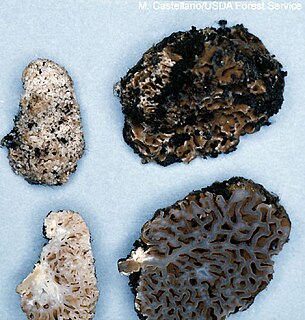
Petter Adolf Karsten was a Finnish mycologist, the foremost expert on the fungi of Finland in his day, and known in consequence as the "father of Finnish mycology".

Puccinia is a genus of fungi. All species in this genus are obligate plant pathogens and are known as rusts. The genus contains about 4000 species.

Gautieria is a genus of hypogeal fungi in the family Gomphaceae. They form mycorrhizae with various tree species, mostly from the family Pinaceae. Species are present over much of the world's temperate and boreal forest habitats. It is well documented that species from this genera are an important part of the diet of the northern flying squirrel. Also, some Australian marsupials, especially the rat-kangaroos, feed extensively on these fungi. The fungi also benefit from this relationship: not only do the squirrels help to disperse the spores and propagate the species, studies suggest that passage through the digestive tract of a mammal promotes germination of spores.
Pestalopezia is a genus of fungi in the family Helotiaceae. The genus contains three species.
Gibellina is a genus of fungi in the family Magnaporthaceae, from Italy.
Combea is a genus of lichens in the family Opegraphaceae. It has two species. The genus was circumscribed by Italian botanist Giuseppe De Notaris in 1846.
Gibellia is a genus of fungi within the Melanconidaceae family. According to the 2007 Outline of Ascomycota, the placement of this genus within the Melanconidaceae is uncertain.
Pauahia is a genus of fungi in the family Meliolaceae.

Massarina is a genus of fungi in the Massarinaceae family. The widespread genus contains about 125 species. Anamorph forms of species in Massarina include Acrocalymma, Ceratophoma, and Tetraploa. Massarina was circumscribed by Pier Andrea Saccardo in 1883.
Pegleromyces is a genus of fungi in the family Tricholomataceae. It is a monotypic genus, containing the single species Pegleromyces collybioides, found in Brazil, and described as new to science by mycologist Rolf Singer in 1981.
Delpontia is a genus of fungi within the family Stictidaceae. It is a monotypic genus, containing the single species Delpontia pulchella.
Maronea is a genus of lichenized fungi in the family Fuscideaceae.

Fayodia is a genus of fungi in the family Tricholomataceae. It was first described by Robert Kühner in Bull. Bi-Mens. Soc. Linn. Lyon Vol.9 on page 68 in 1930, and the specific epithet honors the Swiss mycologist Victor Fayod (1860–1900). The widespread genus contains 10 species, mostly in the northern temperate regions.
Grosmannia is a genus of fungi in the family Ophiostomataceae. It was circumscribed by G. Goidànich in 1936.
Burgella is a genus of fungi in the family Clavulinaceae. The genus is monotypic, containing the single species Burgella flavoparmeliae, described in 2007.

Octaviania is a genus of truffle-like fungi in the family Boletaceae. The widespread genus is estimated to contain 15 species.
Frommeella (Frommeëlla) is a genus of rust fungi in the family Phragmidiaceae. The widespread genus contains two species.
Kuehneola is a genus of rust fungi in the family Phragmidiaceae. The widespread genus contains nine species.
Fischerula is a genus of two truffle-like fungi in the family Morchellaceae. First described from central Italy by Oreste Mattirolo in 1928, the genus name honors Swiss mycologist Eduard Fischer. The type species Fischerula macrospora is known only from Italy, while Fischerula subcaulis is found in coniferous and mixed forests of Oregon and Washington.
Gibellulopsis is a genus of fungi belonging to the family Plectosphaerellaceae.






